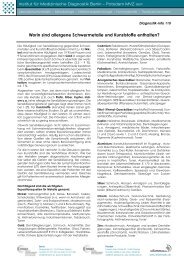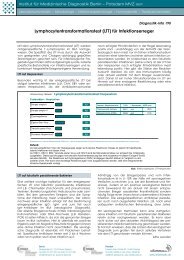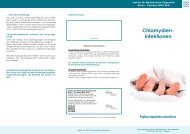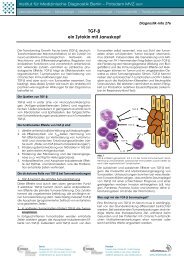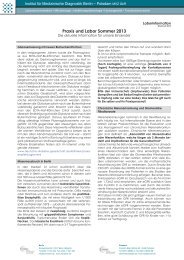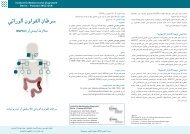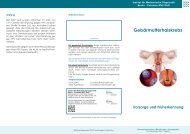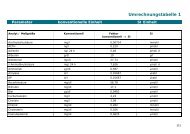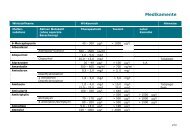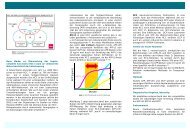Toxoplasmosis in cats - IMD Berlin
Toxoplasmosis in cats - IMD Berlin
Toxoplasmosis in cats - IMD Berlin
You also want an ePaper? Increase the reach of your titles
YUMPU automatically turns print PDFs into web optimized ePapers that Google loves.
Evidence of a toxoplasma <strong>in</strong>fection<br />
<strong>in</strong> humans<br />
<strong>Toxoplasmosis</strong> <strong>in</strong> humans can be detected by<br />
the doctor by analys<strong>in</strong>g a blood sample. The<br />
sample is analysed for antibodies aga<strong>in</strong>st toxoplasma<br />
gondii.<br />
Women who wish to become pregnant should<br />
undergo a medical exam<strong>in</strong>ation for toxoplasmosis<br />
antibodies.<br />
Women that have already suffered from toxoplasmosis<br />
and possess protective antibodies are<br />
safe from renewed <strong>in</strong>fection.<br />
How can humans protect themselves from<br />
toxoplasmosis?<br />
It is not necessary to remove the cat or to stay<br />
away from it, as contact with <strong>cats</strong> as such is not<br />
dangerous but only the contact with cat faeces.<br />
1. Gloves should be worn <strong>in</strong> occupations that<br />
can lead to contact with cat faeces (clean<br />
<strong>in</strong>g of the cat litter box, garden work).<br />
2. Daily clean<strong>in</strong>g and dis<strong>in</strong>fection of the cat litter<br />
box with hot water (more than 70°C) reduces<br />
the risk of <strong>in</strong>fection.<br />
3. Vegetables should be thoroughly washed<br />
before consumption and fruit peeled if<br />
possible.<br />
4. Hands should be washed thoroughly after<br />
prepar<strong>in</strong>g meat.<br />
5. The consumption of raw or <strong>in</strong>sufficiently<br />
cooked meat or sausages (especially pork,<br />
goat and lamb) and untreated milk should<br />
be avoided.<br />
We offer the follow<strong>in</strong>g laboratory tests:<br />
For the cat:<br />
from the faeces:<br />
flotation<br />
from the blood:<br />
antibody attestation for toxoplasmosis<br />
IgG and IgM<br />
For humans:<br />
from the blood:<br />
antibody attestation for toxoplasmosis<br />
IgG and IgM<br />
Additional diagnostic exam<strong>in</strong>ations if necessary<br />
Institut für Mediz<strong>in</strong>ische Diagnostik MVZ GbR<br />
(Institutes for Medical Diagnostics)<br />
Nicolaistr. 22, 12247 Berl<strong>in</strong><br />
Telephone: 030-77001-0<br />
Surgery stamp<br />
We are always pleased to provide you with further<br />
<strong>in</strong>formation.<br />
Institute for Veter<strong>in</strong>ary Medical Diagnostics<br />
Institut für Veter<strong>in</strong>ärmediz<strong>in</strong>ische Diagnostik<br />
Nicolaistraße 22, 12247 Berl<strong>in</strong><br />
Tel.: 030 – 77001 222 , Fax: 030 – 77001 332<br />
<strong>Toxoplasmosis</strong><br />
<strong>in</strong> <strong>cats</strong><br />
SERVICE
The pathogen<br />
Toxoplasma gondii is a s<strong>in</strong>gle-celled parasite and is<br />
found <strong>in</strong> all warm blooded animals and <strong>in</strong> humans.<br />
Def<strong>in</strong>itive hosts are only <strong>cats</strong> that discharge the<br />
<strong>in</strong>fectious eggs (oocysts) with their faeces. Apart<br />
from the oocysts there are two further <strong>in</strong>fectious<br />
phases, an active propagation phase and a<br />
dormancy period <strong>in</strong> tissue cysts. Both are present<br />
<strong>in</strong> the def<strong>in</strong>itive as well as <strong>in</strong> the <strong>in</strong>termediate host.<br />
Intermediate hosts are small animals of prey such<br />
as mice, however all other mammals are able to<br />
become <strong>in</strong>termediate hosts.<br />
<strong>Toxoplasmosis</strong> <strong>in</strong> <strong>cats</strong><br />
Cats become <strong>in</strong>fected with toxoplasmosis ma<strong>in</strong>ly<br />
by <strong>in</strong>gest<strong>in</strong>g rodents or by feed<strong>in</strong>g on raw meat.<br />
Cats that are solely domestic can also become<br />
<strong>in</strong>fected if they are fed for example raw meat.<br />
Cl<strong>in</strong>ical symptoms rarely appear <strong>in</strong> <strong>cats</strong>. Occasionally<br />
slight diarrhoea is noticed <strong>in</strong> affected <strong>cats</strong>.<br />
As a rule affected <strong>cats</strong> discharge oocysts with the<br />
faeces <strong>in</strong> their surround<strong>in</strong>gs only <strong>in</strong> the event of a<br />
primary <strong>in</strong>fection. The oocysts only become<br />
<strong>in</strong>fectious after 2-4 days <strong>in</strong> the environment. The<br />
discharge lasts for a maximum of 10 days. Should<br />
the oocysts be <strong>in</strong>gested by warm blooded animals<br />
(e.g. mice) or humans they can become<br />
<strong>in</strong>fected.<br />
Other mammals do not discharge toxoplasma<br />
gondii. They can however become carriers of<br />
tissue cysts as <strong>in</strong>termediate hosts. The most common<br />
source of <strong>in</strong>fection for humans is the meat of<br />
the affected animals. Dogs also do not discharge<br />
toxoplasma oocysts with their faeces and are<br />
therefore not carriers of toxoplasmosis.<br />
Does my cat constitute a risk of <strong>in</strong>fection?<br />
The risk of <strong>in</strong>fection for a cat can be estimated by<br />
an analysis of a faeces specimen and a blood<br />
sample:<br />
Should the blood test as well as two tests of the<br />
faeces with<strong>in</strong> a 14 day <strong>in</strong>terval prove negative<br />
then the cat is most probably not yet <strong>in</strong>fected with<br />
toxoplasma. Measures to prevent <strong>in</strong>fection can be<br />
taken by e.g. keep<strong>in</strong>g the cat <strong>in</strong>doors and not<br />
feed<strong>in</strong>g it fresh food.<br />
Persons at risk (pregnant women or immuno-suppressed<br />
persons) are to avoid contact with cat<br />
faeces should there be evidence of oocysts <strong>in</strong> the<br />
faeces.<br />
The discharge period of oocysts is most probably<br />
over when antibodies are detected dur<strong>in</strong>g the<br />
blood test.<br />
How can the cat be protected from<br />
toxoplasmosis?<br />
In pr<strong>in</strong>ciple <strong>cats</strong> should not be fed with raw meet<br />
or slaughterhouse waste.<br />
A roam<strong>in</strong>g cat that catches and eats mice is<br />
however not protected from an <strong>in</strong>fection.<br />
Toxoplasma – oocysts <strong>in</strong> the faeces<br />
<strong>Toxoplasmosis</strong> <strong>in</strong> humans<br />
Humans also do not discharge oocysts. They can<br />
however, like mammals, become carriers of<br />
tissue cysts as <strong>in</strong>termediate hosts. In most cases<br />
assimilation however does not ensue from<br />
contact with <strong>cats</strong> or their excrements. The most<br />
common source for <strong>in</strong>fection is the <strong>in</strong>gestion of<br />
raw meet (tartar, raw m<strong>in</strong>ced pork, raw sausage)<br />
followed by fruit and vegetables that are<br />
contam<strong>in</strong>ated with oocysts. Insufficient hygiene<br />
dur<strong>in</strong>g garden work may also lead to assimilation<br />
of oocysts.<br />
A primary <strong>in</strong>fection with toxoplasma normally<br />
does not lead to symptoms <strong>in</strong> a healthy person.<br />
Occasionally fever attacks and flu-like symptoms<br />
can occur (i.a. swell<strong>in</strong>g of the lymph node,<br />
fatigue, exhaustion, headaches).<br />
Should primary <strong>in</strong>fection with toxoplasma occur<br />
dur<strong>in</strong>g pregnancy, the fetal <strong>in</strong>fection risk and the<br />
cl<strong>in</strong>ical pattern depend on various factors. The<br />
later the woman gets <strong>in</strong>fected dur<strong>in</strong>g the course<br />
of pregnancy the higher the probability of a<br />
fetal <strong>in</strong>fection. The earlier <strong>in</strong>fection takes place<br />
dur<strong>in</strong>g pregnancy the more severe the consequences<br />
are for the unborn child.




